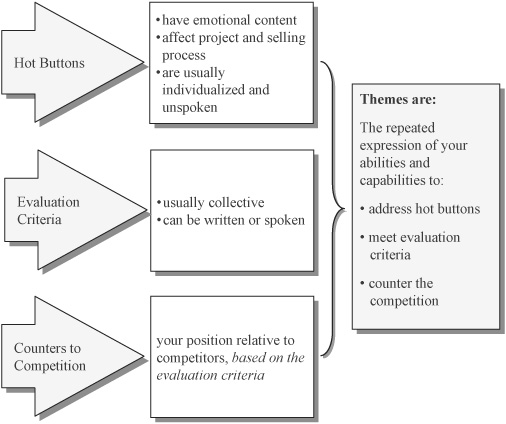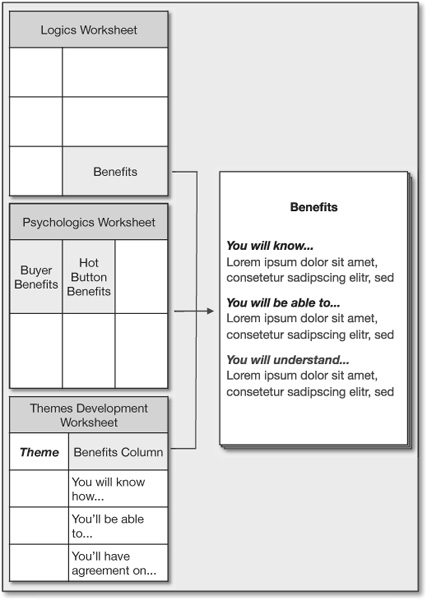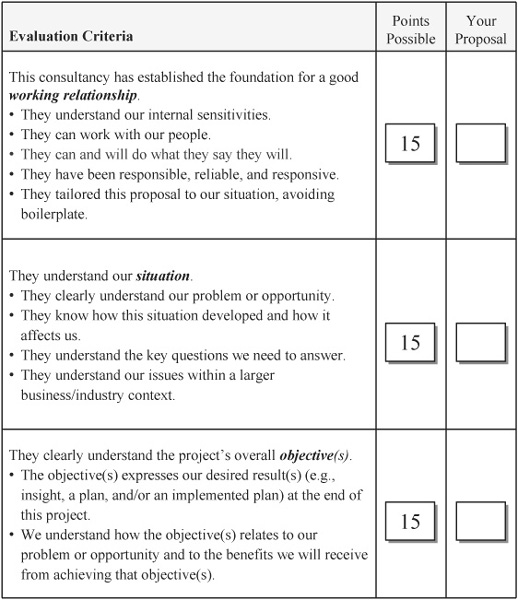CHAPTER 14
Summary: The Proposal Development Process
This is the last chapter in Writing Winning Business Proposals, though there are many important and instructive appendices to follow. You’ve come a long way toward helping yourself get the two to five points that make the difference between winning and coming in a close second. Very few people know what you have learned. Although you have gained considerable insight by reading this book and although you now have a plan for increasing your percentage of winning proposals, you know that insights and plans are necessary but not sufficient. They need to be implemented. Therefore, I encourage you to use the insights you’ve gained and the plan you now have. Use them consciously and often. I’ve brought you out of the forest and to the water; now you have to drink.
This chapter summarizes the plan I’ve presented to you in this book, which has helped you understand how to use proposal logics and psychologics to prepare your documents and presentations. This summary provides you with a snapshot of the proposal-development process I’ve discussed with you, as well as a road map you can use as you develop future proposals.
After the summary, you will find a Rating Guide for Proposals (Figure 14.7 and Figure 14.8). You can use the guide to evaluate your own proposals, since the guide reflects many of the concepts and principles I’ve been helping you learn. Although the guide is based on a 100-point scale, I’ve arbitrarily assigned points to its six major sections. The sections related to methods and to costs/benefits, for example, are worth 20 points each, while those related to the situation and to qualifications are allotted 15. Obviously, you should adjust the allotments on the basis of your proposal situation. In a given situation, for example, qualifications may need to be weighted more heavily than methods.
You also may be able to use the rating guide to help me and my colleagues to establish evaluation criteria, if I haven’t already done so, or to revise those criteria if it’s in your interest to do so. That is, you may find it opportune and helpful to discuss the guide with me. As a result, you may have a clearer idea of what I expect and of what you need to deliver.
In the Introduction, I challenged you to work hard to understand the concepts and principles presented. None of these concepts and principles is particularly difficult to understand. But using them intelligently and well takes effort and practice. Now I challenge you to work hard to practice them, to implement them, remembering that most successful business developers are made, not born. Practice never makes perfect, because perfect doesn’t exist. But practice does lead to continuous improvement. You’ve already improved; continue to do so.
The Proposal Development Process
Note: Many of the following steps are iterative, and many of them are coterminous. And all of the terms used are in the downloadable glossary at http://mhprofessional.com/freed.
0. Qualify the Lead by using the explicit criteria referred to in Appendix H as well as those criteria implicitly suggested on the Logics and Psychologics Worksheets.
Proposal Logics
1. Use the Logics Worksheet to create and test the baseline logic (S1 → S2 → B). (Chapter 2 and Chapter 3.)
A. Specify the current situation (S1), which includes the potential client’s problem or opportunity, the triggering event that brought the problem or opportunity to awareness, the effects of the existing problem or the effects of not capitalizing on the opportunity, and the lack of benefits. (Logics Worksheet, Cell 2.)
B. Given that current situation, specify the desired result or results (S2) that your proposed project will achieve. S2 can be one or a combination of three kinds: insight, a plan, or an implemented plan. Your project’s objectives always express the desired results (Logics Worksheet, Cells 3 and 5).
C. Given the current situation and desired result, specify the deliverables that you will produce to achieve the desired result (Logics Worksheet, Cell 5).
D. Given the deliverables and the desired result, specify the benefits (B) likely to accrue from producing deliverables and achieving the desired result (Chapter 12; Logics Worksheet, Cell 6).
E. If the desired result is insight or a plan, use a measurable-results orientation to indicate the benefits likely to accrue after subsequent implementation (Chapter 4; Logics Worksheet, Cell 6).
F. Test the alignment of the elements within the baseline logic by answering the following questions (Chapter 3; Logics Worksheet, Cells 1–6):
![]() Are the prospect’s strategic direction, triggering event, overriding problem, and effects aligned?
Are the prospect’s strategic direction, triggering event, overriding problem, and effects aligned?
![]() Are the overriding question(s), objective(s), and desired result(s) aligned?
Are the overriding question(s), objective(s), and desired result(s) aligned?
![]() Is the overriding problem aligned with the overriding question(s)?
Is the overriding problem aligned with the overriding question(s)?
![]() Are the deliverables aligned with the desired result(s)?
Are the deliverables aligned with the desired result(s)?
![]() Are the deliverables and desired result(s) aligned with the benefits?
Are the deliverables and desired result(s) aligned with the benefits?
![]() Are the benefits aligned with the effects/lack of benefits?
Are the benefits aligned with the effects/lack of benefits?
2. Construct the methodology to define how to achieve the objective (Chapter 5).
A. Clearly identify the objective (or objectives), based on the buyers’ overriding question (or questions). If the project will move the buyer one step (for example, from lacking insight to having insight), there will be only one overriding question and objective. If the project will move the buyer two or more steps (for example, from lacking insight to having a plan), there will be two or more objectives.
B. Place the objective at the top of a logic tree that organizes the actions necessary to achieve it. (Be certain each action specifically expresses a result, a deliverable.) Build one logic tree for each objective.
C. Once the logic tree is constructed, list the action-results in sequence.
D. Within that sequence, integrate the activities important for planning and communicating.
E. Consider the elapsed timing of each action to determine the project’s duration.
Proposal Psychologics
3. Identify the role or roles played by each buyer on the consultant-selection committee, and specify the individual benefits that will accrue to each buyer from achieving the desired result (Chapter 6; Psychologics Worksheet, Cell 1).
A. Classify all the members of the buying team according to the role or roles each will play in making the decision: economic buyer, user buyer, technical buyer, coach, ratifier. Remember that a single buyer can play as many as the first four roles; a ratifier can play only one other role: coach (Psychologics Worksheet, Cell 1).
B. Identify for each buyer the likely benefits that will accrue from achieving S2, remembering that those benefits will be conditioned by the buyer’s role and position in the organization (Psychologics Worksheet, Cell 1).
C. If at all possible, develop at least one coach (Psychologics Worksheet, Cell 1).
4. Identify, select, and develop your themes (Chapter 7 and Figure 14.1).
A. Identify possible themes by considering the following:
![]() Hot buttons—the desires or concerns of individual buyers that, if addressed, will affect your selling process, project organization, and/or project methodology (Psychologics Worksheet, Cell 2).
Hot buttons—the desires or concerns of individual buyers that, if addressed, will affect your selling process, project organization, and/or project methodology (Psychologics Worksheet, Cell 2).
![]() Evaluation criteria—the criteria developed by the consultant-selection committee often contained in RFPs (Appendix G) and other documents (Psychologics Worksheet, Cell 4).
Evaluation criteria—the criteria developed by the consultant-selection committee often contained in RFPs (Appendix G) and other documents (Psychologics Worksheet, Cell 4).
![]() Counters to the competition—your strengths relative to the competition, especially as those strengths apply to evaluation criteria for this particular project or selling opportunity (Psychologics Worksheet, Cell 5).
Counters to the competition—your strengths relative to the competition, especially as those strengths apply to evaluation criteria for this particular project or selling opportunity (Psychologics Worksheet, Cell 5).
B. Select the themes by considering the following (Chapter 7):
![]() Hot buttons of medium- and high-power-base buyers whose receptivity you want to maintain or increase (Psychologics Worksheet, Cells 2 and 3). Power base refers to a buyer’s relative influence in this selling opportunity, not to that buyer’s general level of influence within his or her firm. Receptivity refers to a buyer’s relative reception to your selling efforts to date.
Hot buttons of medium- and high-power-base buyers whose receptivity you want to maintain or increase (Psychologics Worksheet, Cells 2 and 3). Power base refers to a buyer’s relative influence in this selling opportunity, not to that buyer’s general level of influence within his or her firm. Receptivity refers to a buyer’s relative reception to your selling efforts to date.

FIGURE 14.1 Identifying your themes
![]() Evaluation criteria on which you believe you rate highly or that the buyers weight heavily.
Evaluation criteria on which you believe you rate highly or that the buyers weight heavily.
![]() Counters to the competition that provide you with an opportunity to significantly counter competitors’ arguments or moves, remembering that your competition can also include in-house individuals or other initiatives competing for the same limited resources.
Counters to the competition that provide you with an opportunity to significantly counter competitors’ arguments or moves, remembering that your competition can also include in-house individuals or other initiatives competing for the same limited resources.
C. Develop the themes on the Themes Development Worksheet.
5. Derive the project’s benefits from the following worksheets:
A. Baseline Logic Benefits (Logics Worksheet, Cell 6).
B. Buyers’ Benefits (Psychologics Worksheet, Cell 1).
C. Hot Button Benefits (Psychologics Worksheet, Cell 2).
D. Themes Development Benefits (Themes Development Worksheet, Benefits column).
6. As you work, add red and green flags to your Logics and Psychologics Worksheets: a red flag to indicate a weakness, vulnerability, or gap in information; a green flag to indicate a strength.
7. Conduct a 40-minute Green Team Review (Chapter 8) to review your strengths and weaknesses and to identify strategic actions to address them. Conduct one or more Green Team Reviews before investing significant time in proposal preparation. Take whatever actions you and your team believe appropriate (and have the time and resources to implement) to eliminate red flags and leverage green flags.
Proposal Preparation
8. Using the situation and objectives slots, write a background section (Chapter 9 and Figure 14.2) that includes:
A. A Story Component using information from the Logics Worksheet, Cells 1 and 2.
B. A Questions Component that identifies the key questions that must be answered to eliminate the problem or capitalize on the opportunity. (Use the second and lower rows of the logic tree for the methodology to generate some of these questions; also use deliverables from the Logics Worksheet, Cell 5.)
C. A Closing Component that states the project’s objectives (Logics Worksheet, Cells 3 and 4) and ends with briefly stated benefits (Logics Worksheet, Cell 6).
9. Write a methods section that, when necessary and appropriate (Chapter 10 and Figure 14.3):
A. At the section level, composes the section’s opening P-slot from the Situation and Methods columns of the Themes Development Worksheet to provide a rationale that explains why, out of a universe of possible approaches, you will use this approach in this situation.
FIGURE 14.2 Writing the background section

FIGURE 14.3 Writing the introduction, the opening P-slot, to the methods section
B. At the task level, fills each task’s opening P-slot by providing a rationale for why the task should be performed; uses a logic tree to fill each task’s I-slot (Chapter 4 and Figure 14.4) by explaining how the task will be performed; fills each task’s closing P-slot by explaining what will result from performing the task.
10. Write a qualifications section (Chapter 11 and Figure 14.5) that:
A. Explicitly discusses abilities and capabilities as they intersect with the buyers’ needs.

FIGURE 14.4 Using PIP at the task level

FIGURE 14.5 Writing the qualifications section
B. Uses a logic tree to develop the claim, “We are the best-qualified firm.” (Use the Qualifications column of the Themes Development Worksheet to develop this logic tree.)
11. Write a benefits section summarizing the proposal’s major selling points and including, when necessary and appropriate (Chapter 12 and Figure 14.6):

FIGURE 14.6 Writing the benefits section
A. Baseline Logic Benefits (Logics Worksheet, Cell 6).
B. Buyers’ Benefits (Psychologics Worksheet, Cell 1).
C. Hot Button Benefits (Psychologics Worksheet, Cell 2).
D. Themes Development Benefits (Themes Development Worksheet, Benefits column).
12. Determine the proposed fees (Chapter 13) considering the prospect’s return on consulting investment (and the large number of other measurable as well as nonmeasurable factors influencing the project’s value) and the potential risks to you and your firm.
13. Be certain that your document’s sentences and voice are appropriate for the situation (Appendix E and Appendix F).
14. Evaluate the proposal by using the Rating Guide and/or the Lead Qualification Worksheet referred to in Appendix H, making certain to weight the various factors based on the situation while trying to view your efforts from the prospect’s perspective (Figures 14.7 and 14.8).
FIGURE 14.7 Rating Guide for Proposals, p. 1



